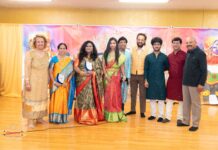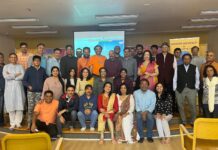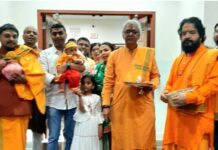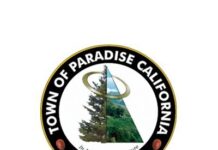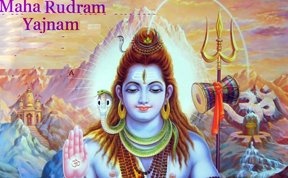 GRAYSLAKE, Illinois: The Hindu Mandir in Grayslake – Lake County is hosting a three-day celebration of Maharudram Yajnam in Grayslake from May 2 to May 4. It is expected to be attended by hundreds of devotees not only from Chicgoland but neighboring States of Wisconsin and Indiana too. Maharudram essentially means worshiping Lord Shiva, the Para Brahman, visualized as Rudra-Siva who teaches the supreme knowledge to all and whose energy flows in everything.
GRAYSLAKE, Illinois: The Hindu Mandir in Grayslake – Lake County is hosting a three-day celebration of Maharudram Yajnam in Grayslake from May 2 to May 4. It is expected to be attended by hundreds of devotees not only from Chicgoland but neighboring States of Wisconsin and Indiana too. Maharudram essentially means worshiping Lord Shiva, the Para Brahman, visualized as Rudra-Siva who teaches the supreme knowledge to all and whose energy flows in everything.
The Vedas
Hindus have many holy books like the Bhagavad Gita and the Ramayana but there is a single common scripture that is considered holy by all sections of Hindus.
It is called the “Vedas.” The word Veda comes from the Sanskrit root ‘Vid’ – “To Know.” So, Veda literally means knowledge or wisdom. The Vedas are considered as Anaadhi or Apaurusheya – without a beginning or human composer. So, there is no copyright!
Vedas have been hailed as the very life-breath of Parameswara, the Almighty! The Vedas are believed to have been heard by the ancient enlightened seers (rishis) and hence called in Sanskrit as ‘Shruti’ (what was heard). They were later transmitted by the Rishis by word of mouth, memorized by their disciples and passed on to us through generations. The Vedas have stood the test of time through centuries and are considered the highest religious authority for all sections of Hindus.
Sri Rudram
Sri Rudram is an essential part of the Vedas and is revered as the crown jewel of Yajur Veda! Just as we pray to Lord Vishnu in Vishnu Sahasranamam, we worship Lord Shiva in the fierce form of Rudra in Sri Rudram.
Sri Rudram has two parts, Namakam and Chamakam, each with eleven sections called Anuvaakas. Each anuvaaka has a number of hymns in different Vedic meters. The first part is called Namakam because there is repeated use of the word “Namah” showing reverence to Lord Shiva. The second part is called Chamakam because the word “Chame” is repeated.
Namakam
In Namakam, we pray to Lord Shiva to shed his fury, drop his weapons and shower benevolence on his devotees. The very first lines of Namakam offer salutations to Lord Rudra and his primary weapons of bow and arrows:
Om Namo Bhagavate Rudraya
(Oh Rudra, My salutations to you.)
Namaste rudra manyava uto ta
ishave namaH
(My salutations to your anger and to your arrows)
Namaste astu dhanvane bAhubhyAmuta the namaH
(My salutations to your bow and to your two fore-arms.)
The hymn stretches further and asks Lord Rudra to shed his anger, and be kind and benevolent. In the subsequent anuvaakas, the Lord is worshipped as an Omnipresent, Omnipotent power that exists in all forms – living as well as non-living – the good and the bad, the beautiful and the ugly, the conceivable and the inconceivable including creatures and green foliage. Namakam bestows peace and bliss to devotees.
Chamakam
After the pacifying chants of Namakam, devotees seek various boons from Lord Rudra in Chamakam. The words Cha me literally mean “and to me.” In Chamakam, a devotee seeks from Rudra numerous items both for worldly living and for spiritual fulfilment – from basic necessities such as grains, food and other materials, to the highest of health and spiritual needs.
The Glory of Sri Rudram
Sri Rudram is cited in hundred and one Yajurveda Sakhas (Yajurveda branches) and Lord Shiva as Rudra is worshipped in hundreds of forms; hence Sri Rudram is also called ‘Shatarudriyam’ (Shata means hundred).
Chanting Sri Rudram is said to offer great benefits as can be seen from a short verse from Soothasamhitai of Vedic literature which explains the essence of “Rudra Japam” (Sri Rudram chanting) as follows:
“Just as watering the root of a tree nourishes all the branches, chanting Rudra Japa (Rudra hymn) pleases all the devatas (all forms of gods). By chanting Sri Rudram with devotion, one gets Bhukti (material enjoyments) and Mukti (freedom from the bondage of re-birth, the ultimate goal).”
Just as melodious music makes us feel happy, listening to the sonorous chanting of Sri Rudram creates vibrations that help to strengthen our mind. In the Maha Rudram event, 121 ritwiks chant Sri Rudram 11 times making it a total of 1331 times. With chorus recitation in such large numbers, the potency and power of mantras in Sri Rudram get significantly enhanced.
The 68th Sankaracharya of Kanchi Kamakoti Peetam, popularly known as Paramacharya, summed up the impact of vibrations of Vedic mantras as follows: “The vibrations of the Vedas serve the purpose not only of creation and the conduct of life. There are indeed Vedic mantras that help us to transcend this life and become one with the Ultimate Truth. Some mantras that create vibrations in our naadis (nerves) accomplish the same noble task of taking us to such a goal.”
Sri Rudram presents Lord Shiva, not only as the Almighty for prayers, but also as the one who is not separate from the devotee. It is the only hymn of its kind that unfolds the concept of God permeating in everything – the pleasant and the creative, so also the dreadful and the destructive. This is a unique concept in Hinduism not found elsewhere!
The benefits arising from Sri Rudram recitation are far too many to describe. Siva Purana explains: “By chanting Rudram, one gains both worldly pleasures and liberation.” Rishi Bodhayana says that chanting Sri Rudram provides relief from all sins and diseases, apart from required wealth, mental peace, long, healthy, and happy life.
Sri Rudram holds a great potential to open up a new spiritual path for the community to gain not just material benefits in this world but seek the ultimate truth behind human existence. Such is the glory of Sri Rudram!
Sundaresan Subramanian (Subi)


